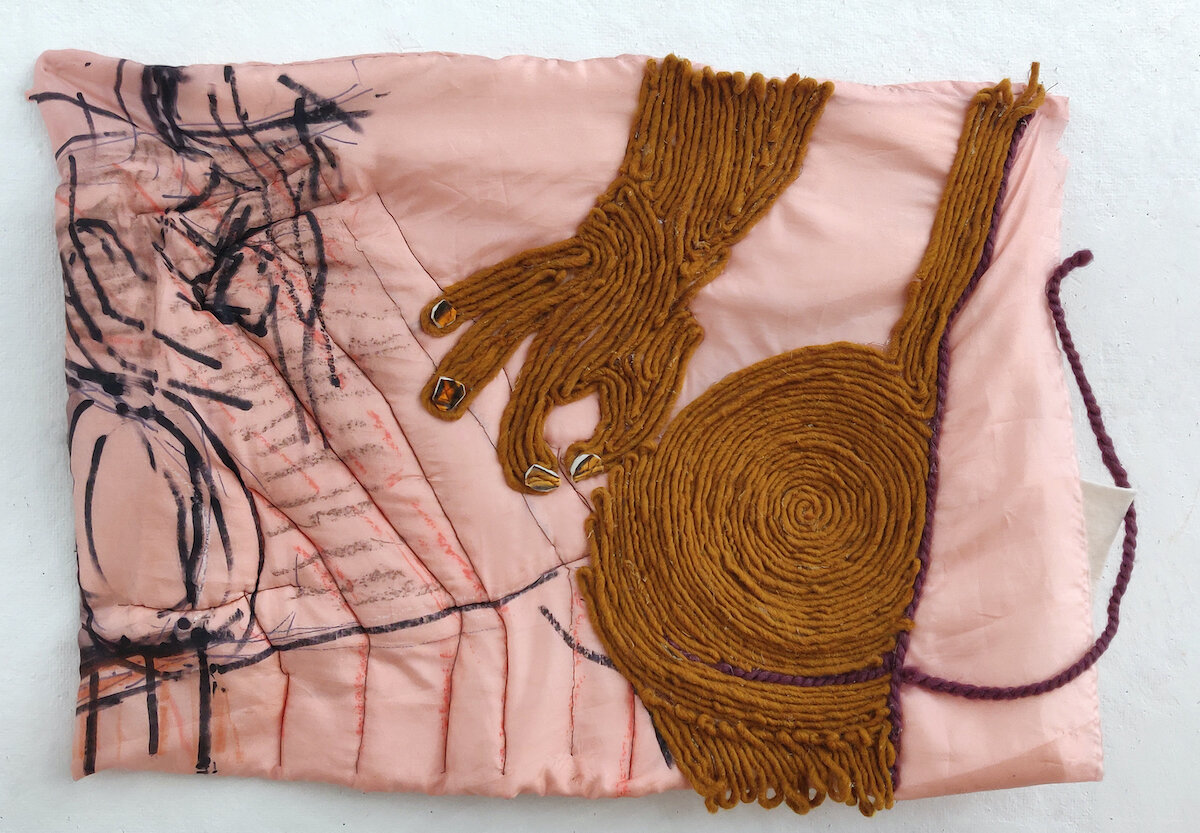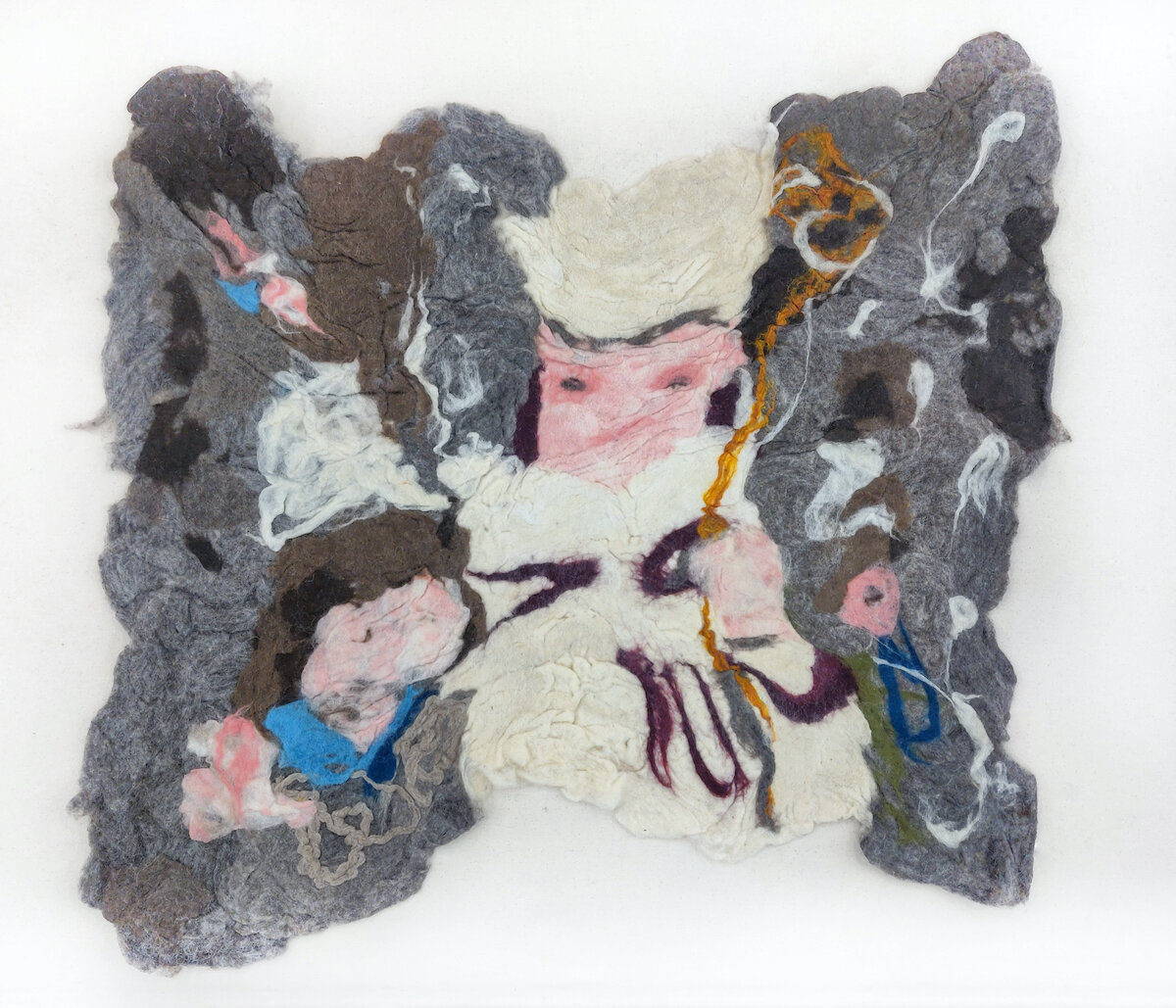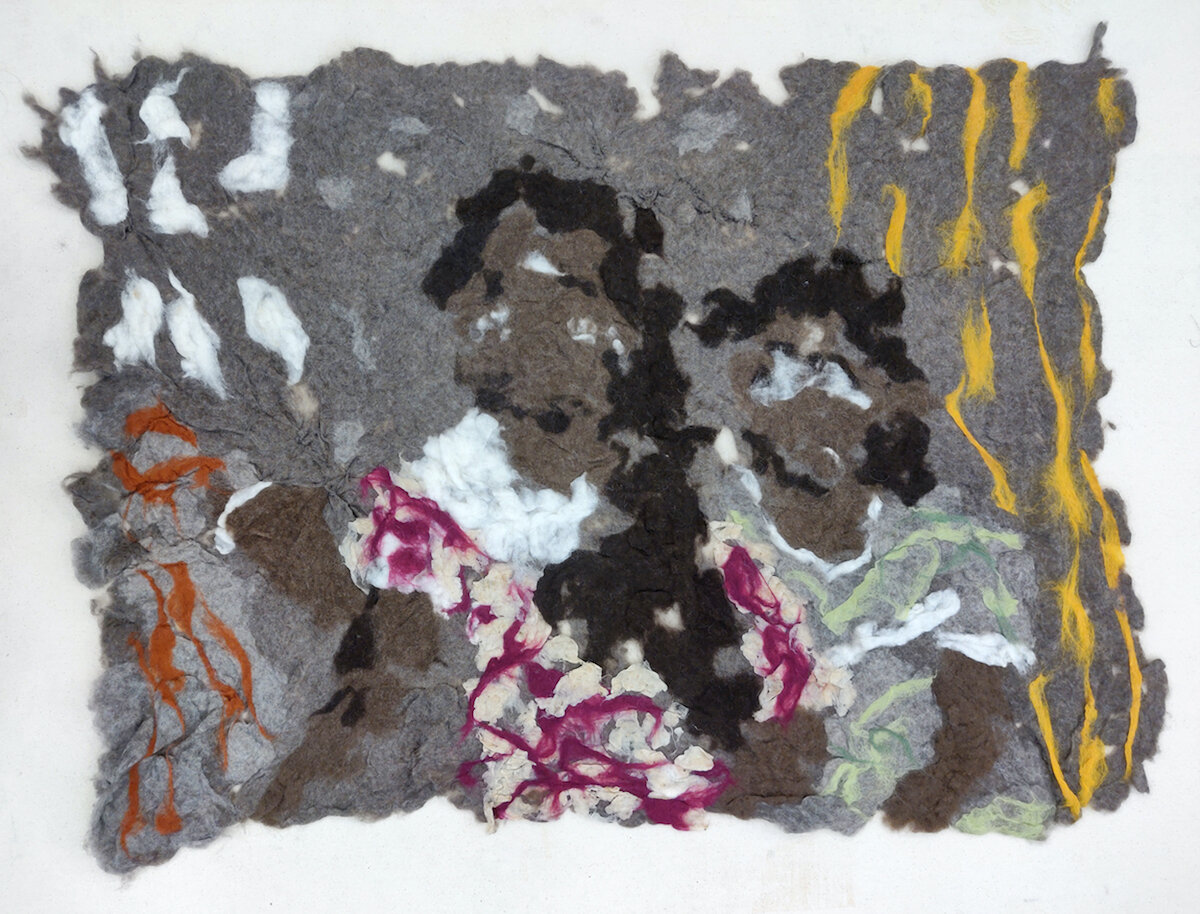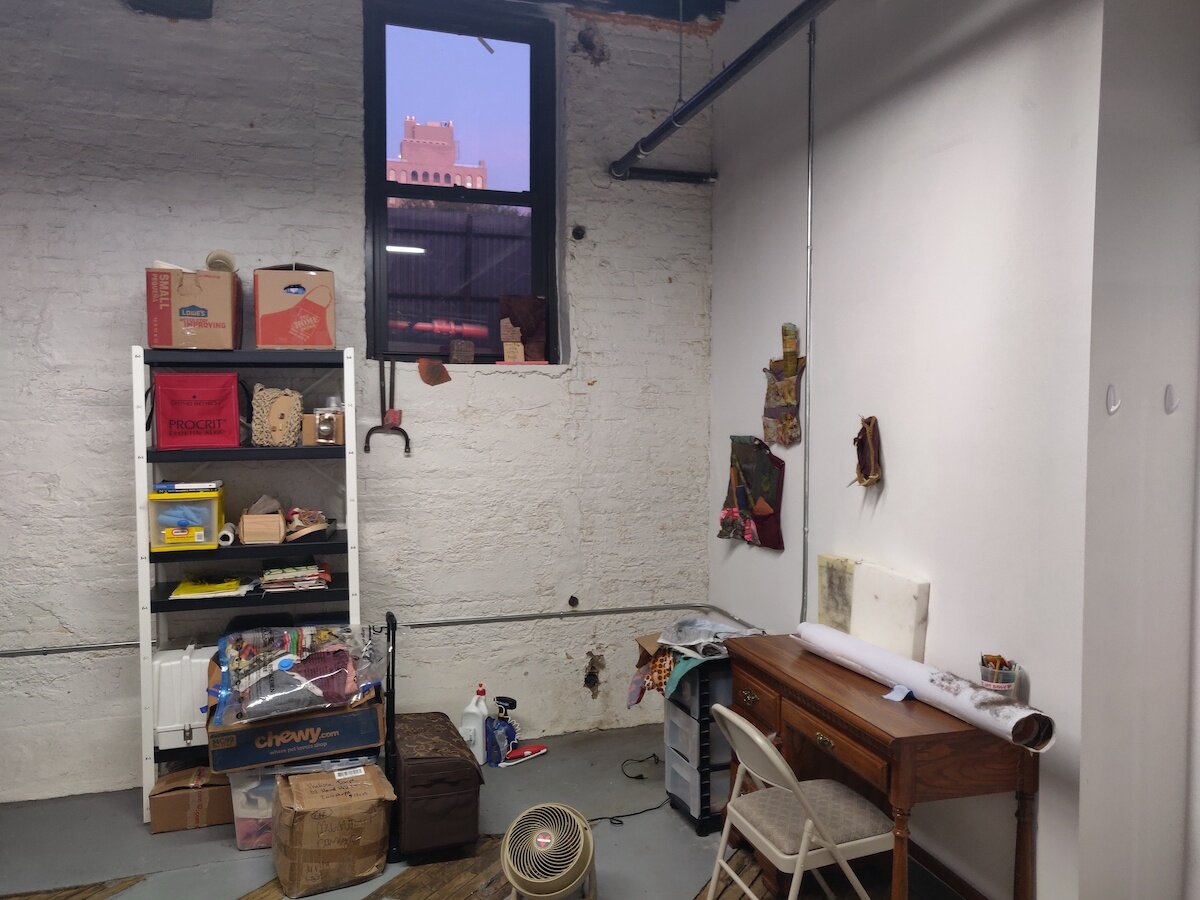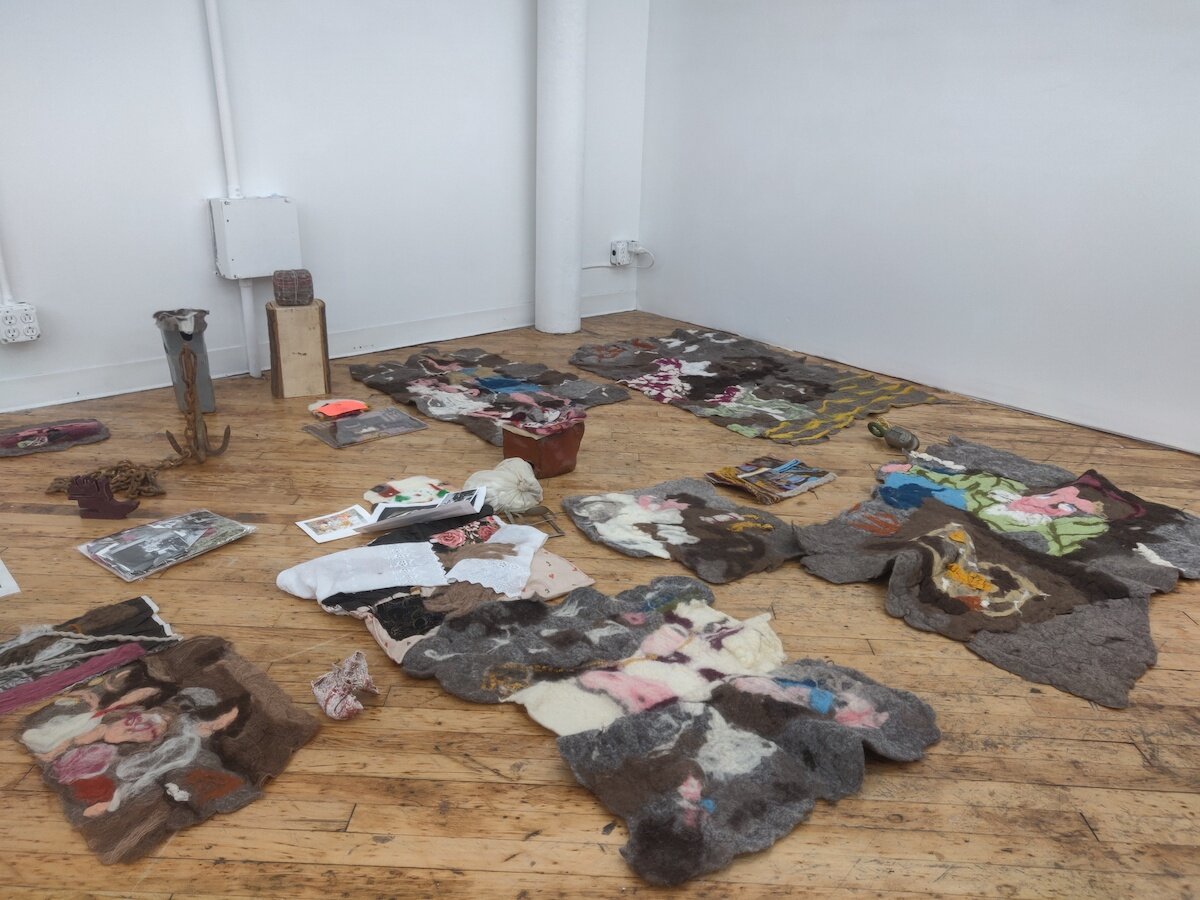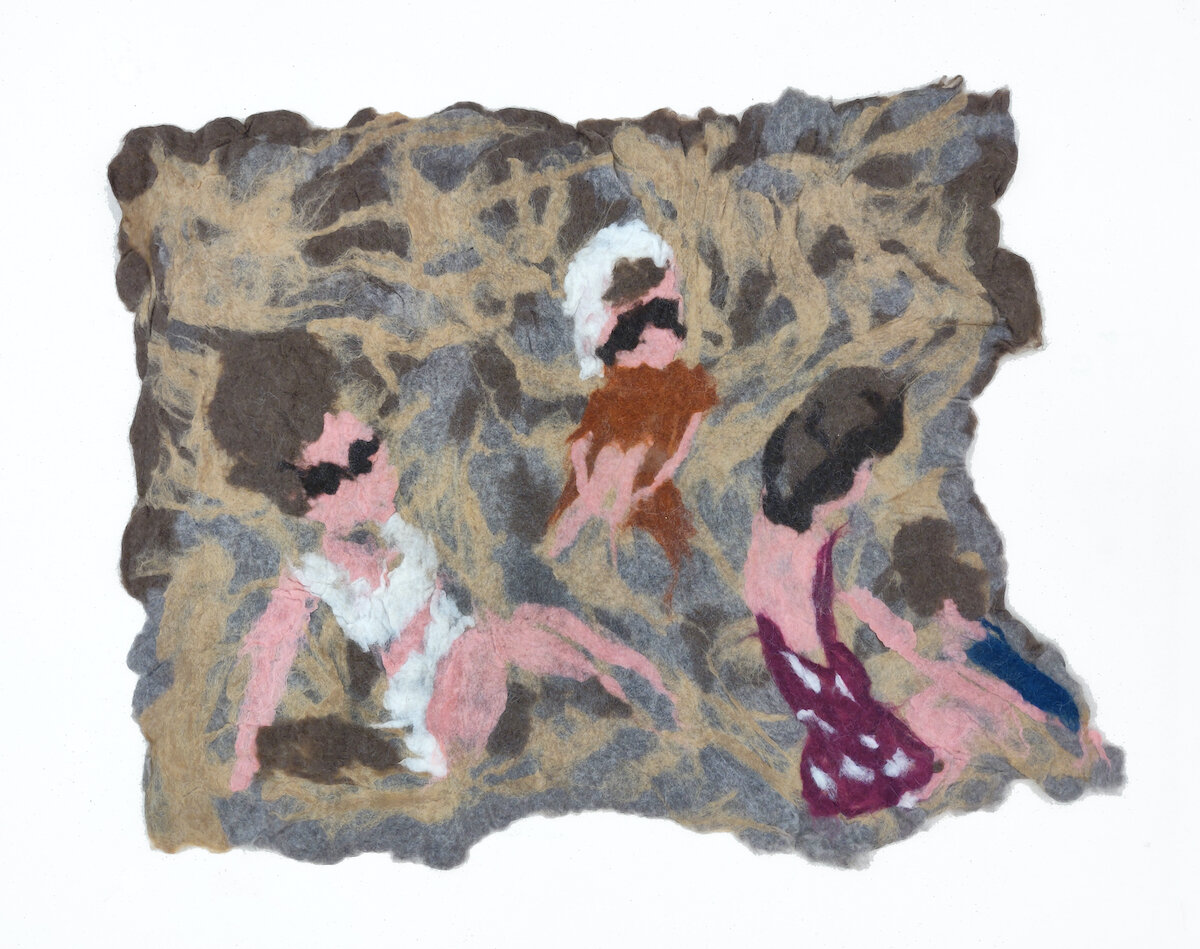Melissa Joseph standing in the Subtle Speaks exhibition at Textile Arts Center, photo credit: Shawn Inglima.
Melissa Joseph
Melissa Joseph is interested in connecting people through shared memories and experiences. Her work addresses themes of memory, family history, and the politics of how we occupy both physical and emotional spaces. Her practice is rooted in exercises of empathy and understanding. Melissa’s work has been shown at the Delaware Contemporary, Woodmere Art Museum, the PAFA Museum, The Growlery, Bemis Center for Contemporary Art, Rider University and featured in New American Paintings, and Friend of the Artist. She is currently an artist in residence at the Textile Arts Center and a Media Fellow at BRIC.
Interview with Melissa Joseph
Questions by Andreana Donahue
Can you tell us a bit about your background and where you grew up? In what ways have your early visual experiences and personal history led to art-making?
I was born and raised in a small town in rural Pennsylvania. My family was different from the rest of the people there for a couple of reasons: 1) We were brown. 2) We were not from there. The aesthetic of the Allegheny National Forest has stayed with me. I am still attracted to the natural materials of that place: wood, stone, wool. We had 4 days of vacation from school every year for deer hunting season. There were a lot of deer heads, antlers, and gun cabinets around people’s homes. Our house was literally full of rainbows. We had rainbow fabric wallpaper, and the same fabric was on the couch and the curtains. There was always art on the walls, both ours and other people’s. My dad painted and my mom was a crafter. There was always a lot going on visually. I think it is why I dream of being a minimalist but can never pull it off.
Where are you currently based and what initially attracted you to working in this community? Are there any aspects of this place that have surfaced in your work?
I live in Brooklyn. I had wanted to come back to NYC for some time, but was a little nervous to do it without some kind of community or network. Then I got accepted to a year-long residency at the Textile Arts Center in Gowanus so I decided to make the jump! It was the best decision I’ve made. The community at TAC is unbelievably supportive, and that is what kept me going through the uncertainty of the pandemic. I have also connected with a lot of other artists, and feel nourished and sustained by the art I have access to by living here. I make work about space, partly because I suffer from geo-emotional claustrophobia. I am certain that the giant exhale that I took when I got here shows in the work.
Can you tell us about your studio and what a typical day is like for you? Do you share space or ideas with other artists while working, or is it a more solitary routine?
I share a studio with a friend. We don’t always overlap our hours, but we do enough that we can share what ideas and get feedback. I like to work alone, but near other people. Because of Covid, I am doing more from my apartment. It means smaller work sometimes, but I don’t tend to work at a very large scale. I have a full time job as a grant administrator, too, so my studio hours tend to be in chunks on nights and weekends. Nothing is typical right now, though!
What criteria do you follow for selecting materials? Do you prefer to maintain a narrow focus or work across diverse media? How do you navigate the limitations and possibilities that result from this path?
I think the materials pick me. I work with so many things, and I don’t adhere to boundaries of what a medium can do or how it can/can’t mix with others. I can break down all kinds of barriers in the work that I feel powerless against outside. I feel tremendous freedom moving across materials, bridging incongruencies, and maybe that’s where the sense of urgency comes from. I don’t feel limited unless I fall into the trap of traditional (read: not inclusive) academic assessments.
Can you walk us through your overall process? How would you describe your approach to manipulating materials? What about decision-making and editing?
I work largely intuitively. Some images and objects speak to me, and I start there. Sorry if some of these answers are overlapping. Reacting to processes and materials is like having a conversation. I can revisit the same images over and over again, coming at an idea from different angles and getting closer or more accurate over time.
Can you talk about some of the ongoing interests, imagery, and concepts that have informed your process and body of work over time? How do you anticipate your work progressing in the future?
Essentially my work is about how bodies move through space. I access this by working with images from my family archive. It is content that I know well and feel some ownership of. Who is allowed to move where and how and with what limitations/expectations? Who is allowed to lack self awareness? In terms of a conceptual framework for the future, I feel like I am on a step and I can see the next step, but I don’t know how to get there yet.
Do you pursue any collaborations, projects, or careers in addition to your studio practice? If so, are there connections between the two?
I started to become involved in curating exhibitions. It was an unexpected turn, but it brings me so much joy. It’s a way to lift up others and share my excitement about their work. I also get to think about the relationships between different artists and have some great conversations. I realized I was curating things in my mind or on my instagram feed all the time, so formalizing it just meant that more people could see it. There is a group called Assembly Room that is a wonderful and supportive community for independent women curators.
As a result of the pandemic, many artists have experienced limited access to their studios or loss of exhibitions, income, or other opportunities. Has your way of working (or not working) shifted significantly during this time? Are there unexpected insights or particular challenges you’ve experienced?
Luckily for me, I was able to access my studio at the Textile Arts Center during the pandemic. I went a few times a week and kept making work. My day job is still remote, which allows me to fill my non-commute with studio time. I still worked at home many days, especially in the height of the quarantine. I think a big difference I am noticing is that some people are finding that working is a way through the discomfort and others are sort of paralyzed. It’s been interesting to see the way it’s impacting my friends’ work in different ways.
Big Mom and Big Dad, 2020. Found fabric, quilt batting, acrylic paint, chalk pastel, sharpie, yarn, thread, hot glue, 36 x 36”
In a time that seems to be marked by uncertainty, collective anxiety, and increasing social unrest, why do you think the perspectives and contributions of artists remain meaningful? Do you feel a natural relationship exists between your work (or the role artists play more broadly) and confronting established systems - of power, cultural institutions, or otherwise?
I am still working through this one. Obviously art has had political impact historically, and continues to do so. What I am trying to figure out--and I am naive about this-- is why artists haven’t been able to break free from the white supremacist and patriarchal institutions that bind them so tightly. I have been pretty vocal in a protest campaign against one of my alma maters. The President sent out a non affiliation notice for employees directing them not to associate their BLM protesting with the school. I found this extremely problematic, especially for Philadelphia. A few undisclosed layers in, it became apparent that many of the (90%+ white male) board members also sit on boards of police unions around the city. Needless to say, nothing has been done to address the situation on a meaningful level. They just hired an expensive PR team.
These conflicts of interest are everywhere. I remember a talk given by the Guerilla Girls once explaining that there is not a check and balance system for this. I think it’s mad that the statistics they’ve been posting for decades about the lack of women representation on gallery rosters, museums collections, and in the film industry have barely budged in 20 years.
Can you share some of your recent influences? Are there specific works - from visual art, literature, film, or music - that are important to you?
The political climate is a big influence. It is really important for me to be connected and in conversation with other artists. I am constantly on Zoom for classes, lectures, interviews-sometimes 2 at time (one on my phone and one on my computer). I participate in discussion groups, attend virtual exhibitions, lectures. It’s a little bit manic at times, but it’s how I feel engaged and able to make work in response. I have been listening to anything I can with Dr. Kelli Morgan. The Brooklyn Rail has great lunchtime talks, too.
Who are some contemporary artists you’re excited about? What are the best exhibitions you’ve seen in recent memory?
I am excited about so many artists! Doris Salcedo, Bronwyn Katz, Wendy Red Star, Cyrilla Mozenter, Deidrick Brackens, Billy Zangewa, Bony Ramirez, Donte K. Hayes, Anya Paintsil, Enrico Riley, Vivan Suter, and Marlon Wobst. I just saw one of the best shows of my life at the Bronx Museum: Sanford Biggers’ Code Switch. Everything about that show was perfect to me. There is also a gallery in Sao Paulo that is my dream gallery. It’s called Central Galeria. I love all the work they show-- I want to live in that place!
What are you working on in the studio right now? What’s coming up next for you?
I am still felting away, and trying new things. Adding new materials, embedding it into plaster. There are endless ways to experiment. I also have two shows that I curated coming up in November, and I am REALLY REALLY excited about them. One is at a gallery that is 1/12 scale called Shelter In Place. The other will be a virtual exhibition through the Textile Arts Center. I am working with amazing artists and I can’t wait to share them with everyone in the coming weeks.
